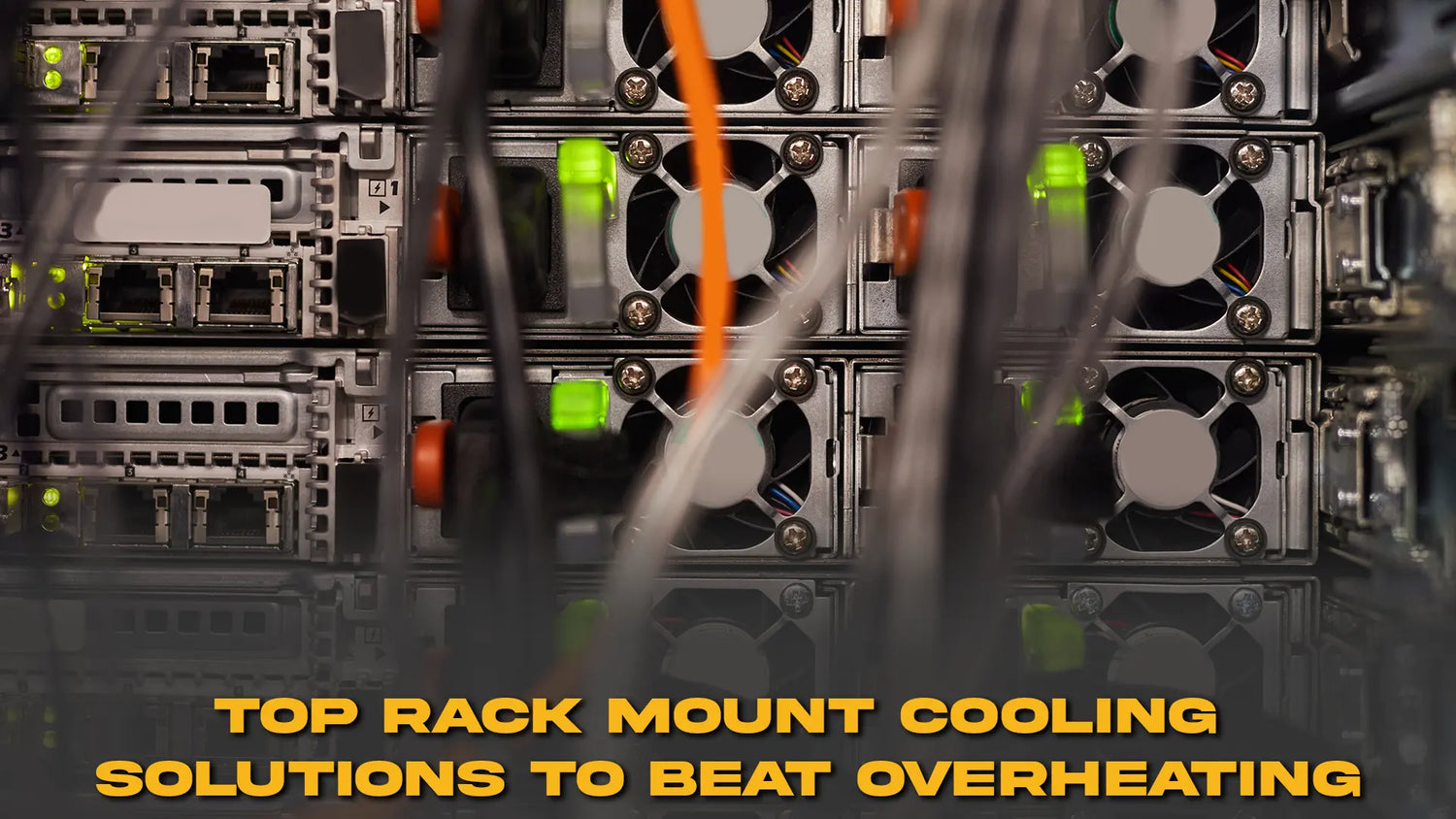Nowadays, in a data centric environment, maintaining temperature is crucial in the server room for the longevity and performance of equipment. And one of the primary cooling means of maintaining rack temperature is rack mount cooling. These systems are specifically created to cool the heat generated from servers and network devices in a rack enclosure. By virtue of its control over airflow and temperature, rack mount cooling contributes to preventing hardware failure, reducing downtime, and enhancing energy efficiency.
As server racks continue to get denser with high end equipment, traditional cooling methods begin to fail in the most demanding situations. This increased demand calls for specialized cooling technologies that can efficiently handle concentrated heat loads. Let us look at the leading cooling solutions available today, review their features and benefits, and see how they can be practically applied. This will help you select the best option for your own setup.
Understanding the Importance of Rack Mount Cooling
In rack malt cooling: Modern data centers, server rooms, and networking closets require their environment to be conditioned in alignment with the chill and moisture tolerances of the rack mount equipment being installed. Any inadequacy in cooling capacities would lead to rapid build up of heat within the equipment, thus directly impairing their performance or causing catastrophic failure. Servers and other rack mounted devices generate enormous amounts of heat while processing data and during other operations. This heat has to be dissipated effectively in order to maintain the integrity of operation.

One important factor in rack mount cooling is managing airflow within the rack. Proper airflow ensures that hot air is expelled and cool air is drawn in, thereby preventing the formation of heat spots inside the enclosure. Many data centers deploy rack cooling systems to tackle the problem of moving air efficiently through and past the equipment. These solutions not only improve the reliability of the equipment but also save energy by avoiding the use of the heavy air conditioning for the whole room.
With increasing server densities and maximizing equipment power, more efficient cooling is more welcomed. Hence, data center managers together with IT professionals must weigh their available rack mount cooling options in order to obtain the best compromise on performance, cost, and ease of maintenance. This knowledge provides the foundation.
Best Rack Mount Fans: The First Line of Defense
One of the simplest and most effective rack mount cooling methods is by employing best rack mount fans. These fans fit elegantly into standard rack space and blow air directly over the components that generate heat. Rack mount fans will keep the air moving around, hence preventing hotspots in the rack.
The cooling requirements depend on the size, speed, and airflow capacity of these fans. Many have variable speeds to allow data center managers to adjust fan speed based on temperature readings received from the site instantly. By doing this, it would ensure the cooling efficiency and save energy when complete cooling is unnecessary. Based on noise levels, such fans would also be the best option for an office environment requiring controlled noise levels.
Most of the best rack mount fans are easy to install and come with thermal sensors and dust filters, which make it easier to cool and maintain. When combined with other rack cooling systems, rack mount fans form a vital part of a comprehensive thermal management strategy for server racks.
Advanced Rack Cooling Systems for High Density Environments
While the individual rack mount fans are more or less local cooling solutions, many data centers require a more complex rack cooling setup to sustain the tremendous heat load generated by high density racks. These systems combine various cooling components, such as fans, ducts, and air conditioning units, designed specifically for rack level heat removal.

A popular type of advanced system is a rack mount air conditioner, which is intended for precise temperature control inside the rack enclosure. Extending the cooling capability outside the basic room cooling, it provides a clean flow of cold air directly toward the equipment for a more efficient heat dissipation. These rack mount air conditioners can be used where room cooling is not adequate or where equipment racks are located in cramped spaces.
Other integrated rack cooling options include liquid cooling and rear door heat exchanger systems, which better dissipate heat through novel methods. These solutions reduce dependence on conventional air cooling and enhance overall cooling efficiency. In view of continuous data center expansion and rapidly increasing cooling requirements, it is a strategic investment to rear end operations with advanced rack cooling solutions.
Exploring Data Center Cooling Solutions Beyond the Rack
While rack mount cooling is focused on protecting the rack enclosure, it is best to look at the more general aspects of data center cooling that complement the efforts at the rack level. These solutions take care of temperature and airflow for the entire data center room or facility and work alongside the rack level technologies.
Another traditional data center cooling method will be to have CRAC (Computer Room Air Conditioning) units and CRAH (Computer Room Air Handling) units maintaining ambient temperature and humidity levels. In fact, these systems are assisted further by aisle containment where the hot aisle and cold aisle are segregated for the best airflow conditions. The combined strategy reduces thermal mixing and enhances cooling performance.

When combined with effective cooling solutions and products, such as specialized fans or air conditioners designed for server racks, these can be considered broader strategies for data center temperature management; therefore, serving as a multi layered approach to preventing overheating. By addressing heat at various sources, data centers maintain the cool temperature of their critical infrastructures and ensure they remain operational during peak load.
Benefits and Features of Rack Mount Air Conditioners
Rack mount air conditioners are specialized units designed to sit directly within or on top of server racks. In contrast to the room based air conditioning systems, these systems channel cold air to an exact location, thereby reducing wasteful cooling capacity and subsequent conservation of energy.
Among the many benefits of rack mount air conditioners is maintaining interior rack temperature and humidity levels constant while ambient conditions sit unfavorably. This precision cooling protects sensitive equipment from thermal stress and gives hardware a longer life span. Many modern units come with smart control and monitoring features, allowing admins to manipulate settings from a distance and get alerts when temperatures climb above safe threshold levels.
The other thing is that rack mount units were designed to be small enough to fit within a normal rack space, allowing easy integration that doesn’t eat into needed floor space. Modular and scalable, they find a use in everything from tiny server closets to massive data centers with hundreds of racks.
Rack Cooling Units: A Comprehensive Solution
Rack cooling units refer to integrated cooling devices that combine different cooling methods such as fans, air conditioners, and heat exchangers all within one unit. These solutions offer a strong set of countermeasures against heat generation inside server racks, most adequately in environments with huge equipment density.
These units are designed for air flow and thermal management efficiency with directional fans, adjustable vents, and occasional liquid cooling loops. The benefit of these rack cooling units is that it offers balanced cooling at all equipment levels within the rack so that no equipment is left susceptible to overheating.
Some rack-mounted cooling units are equipped with monitoring sensors that measure temperature, humidity, and airflow. This information can be fed into the building management system to dynamically plan processes and reduce operating costs. Rack mounted cooling units offer an elegant solution for any organization seeking a simple and efficient cooling solution.
Optimizing Server Rack Cooling with Rack Mount Cooling Fans
Cooling fans designed for server racks are essential tools for fine tuning airflow within the rack environment. Typically, these fans are positioned strategically at the front or rear of the rack to help push in cool air or pull out warm air.
These fans come in various sizes and airflow capacities (CFM - cubic feet per minute). Choosing the right fan involves balancing the needed air volume with noise levels and power consumption. Many models also offer convenient features like tool free installation and washable filters for easier maintenance.
Similarly, these fans often operate alongside specialized air conditioners or room level CRAC units, creating multiple layers of thermal management. This integration continuously moves heat away from critical components, keeping them in optimal working conditions and reducing the risk of failure caused by overheating.
Choosing the Right Rack Mount Cooling Strategy
The selection of an appropriate rack mount cooling strategy depends upon the requirements of the server environment in question. A good rack mount fan installation will suffice in small or sparse racks to provide adequate airflow for heat dissipation. As densities grow, however, they increasingly use rack mount air conditioners or other integrated rack cooling systems to keep temperatures down to safe operating standards.
Considering the role of higher level data center cooling solutions is important also to complement the rack level cooling efforts. By integrating room level and rack level cooling methods, heat is efficiently dissipated from the entire infrastructural landscape. Monitoring and dynamic cooling controls can help improve efficiency while removing any threat of unforeseen overheating.
With an investment in rack mount cooling technology, a data center, or server room will protect its valuable hardware, increase reliability, and lower energy consumption, a clever prescription for any center struggling with the hazards of overheating.




Dejar un comentario
Este sitio está protegido por hCaptcha y se aplican la Política de privacidad de hCaptcha y los Términos del servicio.